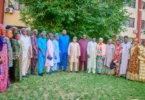The review, covering the first six months of the year, contradicts claims of improved revenue generation by state governments.... CLICK TO READ THE FULL NEWS HERE▶▶
A review of half-year budget performance documents by SaharaReporters reveals that many states would have struggled to pay salaries if they relied solely on internally generated revenue.
The review, covering the first six months of the year, contradicts claims of improved revenue generation by state governments.
In fact, the documents show that several states earned significantly less than their salary expenditures, highlighting a concerning reliance on external funding sources to meet their payroll obligations.

Budget personnel costs surpass internal revenue earnings in several states, indicating a significant reliance on external funding sources for salary payments.
A review of financial records for the first six months of 2024 reveals that Osun State generated N20.3 billion internally, but its personnel costs reached N25.8 billion, creating a shortfall for the half-year period.
Imo State earned N9 billion, yet its personnel expenses totalled N22 billion, highlighting a substantial deficit.
Oyo State’s internal revenue stood at N28.6 billion, while its personnel costs for the same period reached N47.7 billion, indicating a significant funding gap.
Ondo State generated N16.1 billion internally, but its personnel costs doubled that amount, with a wage bill of N32 billion for the first six months of 2024.
Ekiti State’s internally generated revenue (IGR) of N10.7 billion falls short of personnel costs of N13.6 billion. Similarly, Zamfara State’s IGR of N11 billion is outpaced by personnel costs of N16.3 billion.
Imo State’s IGR of N9.6 billion is dwarfed by personnel costs of N22.9 billion while for Kano State, despite an IGR of N24 billion, personnel costs reach N42 billion, indicating a substantial deficit.
Katsina State’s internally generated revenue of N10 billion is insufficient to cover a salary bill of N23 billion and Sokoto State’s IGR of N9 billion for the first six months of 2024 is significantly lower than personnel costs of N27 billion.
Nasarawa State’s IGR of N14 billion is outpaced by personnel costs of N23 billion and for Kogi State, despite generating N12 billion internally, personnel costs reach N29 billion, indicating a substantial shortfall.
In contrast, Bayelsa State’s IGR of N46 billion exceeds its personnel costs of N24 billion, presenting a rare surplus.
Cross River State’s IGR of N16 billion slightly surpasses its personnel costs of N13 billion, demonstrating a relatively healthier financial situation.
Edo State generated N34 billion internally and spent N32 billion on personnel, resulting in a surplus of N2 billion.
However, Niger State’s internally generated revenue of N14 billion fell short of its personnel costs of N25 billion, indicating a deficit of N11 billion.
Plateau State’s internally generated revenue of N11 billion was N6 billion less than its personnel costs of N17 billion, highlighting a funding gap.
Bauchi State’s internally generated revenue of N11 billion was insufficient to cover its personnel costs of N19 billion, resulting in a shortfall of N8 billion.
Adamawa State faced a significant deficit, earning only N5 billion internally while spending N23 billion on personnel costs, leaving a gap of N18 billion.
Yobe State also faced a significant deficit, earning only N5 billion internally while spending N23 billion on personnel costs, leaving a gap of N18 billion.
Borno State’s internally generated revenue of N12 billion fell short of its personnel costs of N17 billion, indicating a deficit of N5 billion.
These examples highlight the challenges states face in meeting their personnel costs with internal revenue, with some of them facing particularly significant funding gaps.
Nigerian states have struggled with inadequate revenue, rendering them heavily dependent on federal allocations. To bridge the fiscal gap, many states have resorted to borrowing, as their internal revenue generation falls short of meeting their financial obligations.
Furthermore, corruption has been cited as a major contributor to the poor revenue performance of states, exacerbating their financial woes and hindering their ability to achieve economic self-sufficiency.











